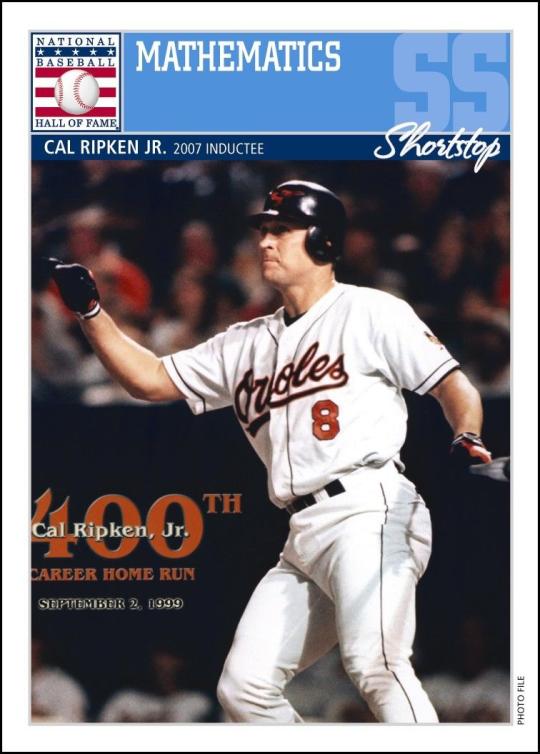Lesson 2: Pre-Visit Slugging Percentage
Lesson
1. Begin the lesson by reviewing that statistics are very important in baseball, so much so that hitters and pitchers often come to be identified by their hitting and pitching stats.
2. Explain that just like batting average, slugging percentage is a comparison statistic. Slugging percentage (SLG) measures a batter’s ability to hit with power.
3. Write down the formula for slugging percentage on the board:
Slugging Percentage = Total Number of Bases
Number of At Bats
4. The number of total bases can be calculated by finding the sum of the following:
• Number of singles x 1 base
• Number of doubles x 2 bases
• Number of triples x 3 bases
• Number of home runs x 4 bases
5. Give students the following practice problem:
• Ryan Howard comes up to bat 7 times in a doubleheader. He hits two singles, one double, no triples, and two home runs. What is his slugging percentage for the two games?
6. Go over the practice problem with students.
• 2 singles x 1 = 2 bases
• 1 double x 1 = 2 bases
• 0 triples x 3 = 0 bases
• 2 home runs x 4 = 8 bases
• 12 total bases/7 at bats = 1.714
7. Explain that just like batting averages, slugging percentages have to be rounded to the thousandths place.
8. Provide each student with a baseball card. Ask students, “Given the information on the back of the card, do you have enough data to be able to determine the player’s slugging percentage?”
9. Guide students to understand that all data necessary for calculating slugging percentage is on the back of the card. While the numbers of doubles, triples, and home runs are listed, the number of singles is not. To find the number of singles, the number of 2B, 3B, and HR is subtracted from the number of hits (H). Once the number of singles is determined, slugging percentage can be calculated.
10. Introduce the activity.
Activity
1. For this activity, students may work individually or in pairs. Provide each student or pair with a “Hall of Fame Hitters” worksheet (included).
2. Have students complete the worksheet.
3. Facilitate an in-class discussion in which students interpret the data they have just calculated. Use the following questions to help guide discussion:
- What is the relationship between a player’s hits and his batting average?
- What is the relationship between a player’s hits and slugging percentage?
- Which player should be considered more valuable to a team: a batter who has a high batting average but few home runs, or a batter who has a modest average but hits many home runs? Why?
4. Discuss the type of graph that would be most useful to compare these hitting statistics: scatter plot, box plot, histogram, etc.
5. Have each student create 2 graphs (class choice) - one showing the data for batting average and one showing the data for slugging percentage. You may choose to have students create their graphs on graph paper, or using software with graphing capabilities such as Excel.
6. Have students identify any patterns they see in the graphs.
Conclusion:
To complete this lesson and check for understanding, for homework, have students research the statistics for two baseball players of their choice. Compare their performances and determine which of the two had a better year statistically. Students should write an analysis that justifies their position.
Common Core Standards
CCSS.Math.Content.HSN-Q.A.1 Use units as a way to understand problems and to guide the solution of multi-step problems; choose and interpret units consistently in formulas; choose and interpret the scale and the origin in graphs and data displays.
CCSS.Math.Content.HSN-Q.A.2 Define appropriate quantities for the purpose of descriptive modeling.
CCSS.Math.Content.HSA-REI.A.1 Explain each step in solving a simple equation as following from the equality of numbers asserted at the previous step, starting from the assumption that the original equation has a solution. Construct a viable argument to justify a solution method.
CCSS.Math.Content.HSA-REI.B.3 Solve linear equations and inequalities in one variable, including equations with coefficients represented by letters.
CCSS.Math.Content.HSS-ID.A.1 Represent data with plots on the real number line (dot plots, histograms, and box plots).
CCSS.Math.Content.HSS-ID.A.2 Use statistics appropriate to the shape of the data distribution to compare center (median, mean) and spread (interquartile range, standard deviation) of two or more different data sets.
CCSS.Math.Content.HSS-ID.A.3 Interpret differences in shape, center, and spread in the context of the data sets, accounting for possible effects of extreme data points (outliers).

